Tooth Restorations
If you have cavities or tooth decay, you will probably need to get dental fillings.
Dental fillings are key to restoring the health and function of teeth. A typical way to fill teeth in the past was to use an amalgam material, which is a silver or mercury material. Luckily, modern advances in dentistry now allow dentists to treat cavities with tooth-colored fillings.
What are Tooth-Colored Restoration?
These tooth-colored restorations are made of composite resin and are able to blend into the color of your teeth. This natural color makes them more attractive, and less noticeable to everyone else. These restorations are used when filling cavities or fixing broken or chipped teeth. If you’ve already received the more traditional amalgam fillings, don’t worry! At Dental Square we are able to replace these fillings with tooth-colored restorations.
The procedure to place tooth-colored restorations is quick and easy! It can be placed in just one visit. First, your teeth will need a thorough inspection and cleaning. After preparing your mouth for the procedure, the dentist will apply a local anesthetic to numb the area and remove any existing caries or debris.
Finally, he or she will place the filling on the tooth, so it fits comfortably and naturally. Your tooth will be ready to use immediately after the anesthetic wears off. With good dental habits and regular cleanings and check-ups, your tooth-colored restorations have the potential to last for many years.
What are Benefits of Tooth Colored Restoration?
The most obvious benefit of tooth-colored restorations is that these fillings match the color of your teeth, hiding them from yourself and others. These fillings are made to appear and feel like your natural tooth enamel, meaning you can eat, drink, and talk without worrying anyone will see silver in your mouth.
Additionally, when compared with silver fillings, tooth-colored restorations have proven to be more resistant to wear and tear and therefore last longer than traditional fillings. This type of restoration is bonded chemically to the tooth and is better able to prevent future decay and damage.

Root Canal Treatment
A root canal treatment is performed if you have a deep cavity exposing the pulp of the tooth or if there’s infection of the pulp.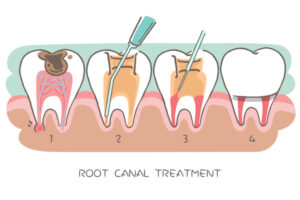
The dental pulp consists of blood vessels and nerves and can become infected if your tooth is damaged by an injury, or if an oral hygiene problem like gum disease, tooth decay or problems with fillings has damaged the protective outer coatings of your tooth. Signs such as Sore and swollen gums, Toothache, Pain when eating or drinking, Facial swellings is indicative of an infected pulp.
A root canal is a treatment used to repair and save a tooth that is badly decayed or becomes infected. During a root canal procedure, the nerve and blood vessels of the pulp are removed, and the inside of the tooth is cleaned and sealed with innate dental material.
Despite common concerns, the procedure isn’t painful, and a timely treatment can save a tooth that might otherwise have to be extracted completely. We will perform the procedure, using local anesthetic and most likely make it a one visit procedure at Dental Square.
After the root canal treatment, you will be advised to secure the tooth with a crown and then we will monitor the tooth to ensure the infection does not return.
What are Dental Crowns & Bridges
If your tooth is broken badly or you need a replacement of missing tooth, you might want to look into dental crowns and dental bridges. These are two of the most common methods of restoring teeth.
What is a Dental Crown?
A dental crown in simple terminology is a cap, or cover, that dentists put over a tooth. Dental crowns help a broken or damaged tooth to gain back its’ normal size, shape, and function. Crowns can even make your tooth stronger and improve the way they look.
There are a few reasons you might want to get yourself a crown; cavities that are too large for fillings, teeth that are cracked or worn down, after having root canal treatment done, or to cover a badly shaped or discolored tooth and fix your smile.
Dental crowns can be made from ceramics, metal alloys, porcelain, porcelain that’s been fused to metal, or composite resin. Whatever the material, it will likely be colored so that it blends in with the natural color of your teeth and enhance your smile.
What is a Dental Bridge?
A dental bridge is the commonest fixed option to replace one or more missing teeth. It is made with two or more dental crowns on either side of a gap made by a missing tooth, with a false tooth (or teeth) placed in between. These types of fake teeth are called pontics, and they can be made of multiple materials such as alloys, porcelain, gold, or a combination of them. The purpose of a dental bridge is just what its name implies, to bridge the gap created by a missing tooth or teeth. The bridge is supported by natural teeth.
You have different kinds of dental crowns, mostly based on the type of material used, such as Porcelain fused to metal/ All Ceramic Crowns/ Zirconia/ Base Metal Alloys/Gold Alloys/ PMMA etc.
Your Dentist will guide you to select the material of choice depending on the aesthetic and load bearing requirement of the questionable tooth, that also suits your budget.
Similarly, there are also different types of dental bridges.
- Conventional dental bridges use dental crowns on either side of the gap which hold the pontics (false teeth) in place. Dental crowns can also be referred to as abutments. These are cemented onto the teeth adjacent to the gap. The downside to conventional bridges is that your dentist will have to remove the enamel from the adjacent teeth to make space for the crowns to be cemented on top, meaning two of your teeth needs to be cut around. In the long term if these teeth decay the bridge may need to be redone with further restorations.
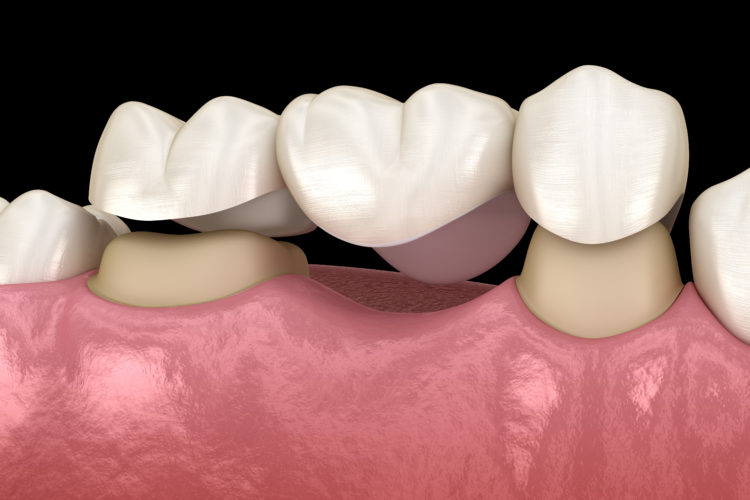
- Cantilever bridges are similar to the traditional ones, except only one side of the pontic will have an abutment supporting it, as opposed to one on each side. So this type can still be used if only one side of the gap has a natural tooth next to it and also if it is not bearing load.
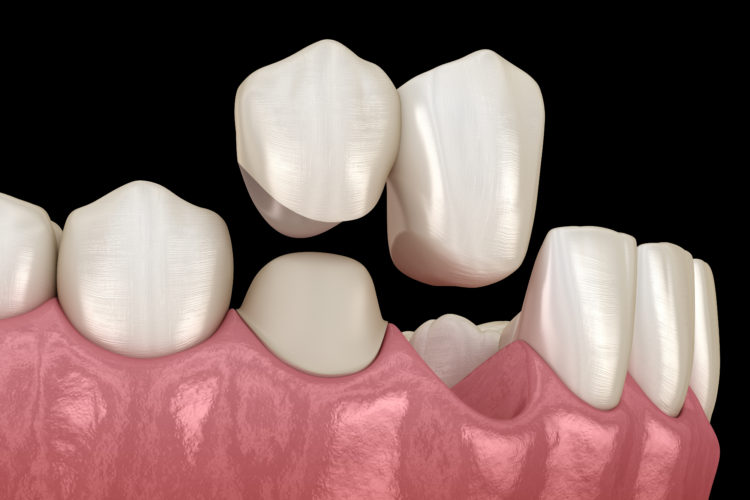
- Maryland bridges consist of a metal or porcelain framework that holds the pontic in place. The framework is bonded to the backs of the two teeth immediately next to the gap. The downside to Maryland bridges is that the strength of the bridge relies solely on the strength of the resin/cement holding it in place. Can detach time to time and needs re cementation.
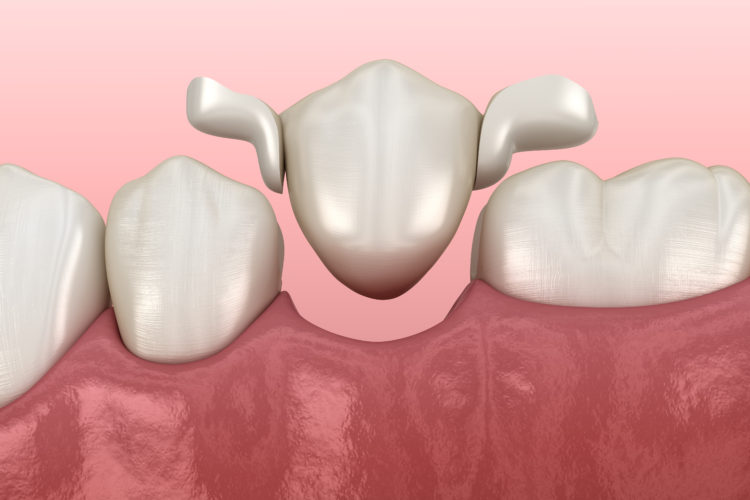
- Implant-supported bridges can be used when there’s more than a single tooth missing. These bridges use dental implants for support instead of tooth abutments or frameworks. These bridges feel very comfortable and secure.
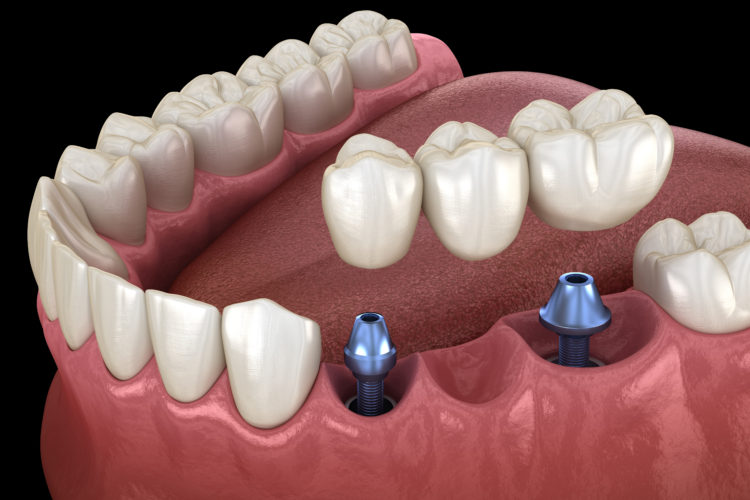
The procedure for crowns is rather simple. The first visit is for investigation and prep. An x-ray will be taken, and an impression will be taken on the tooth. The second visit is for placing the crown.
It’s similar with dental bridges. The first trip to the dentist is for preparation and making impressions and if necessary, placing temporary bridges. A second appointment will be necessary to place the definitive bridge.
Taking care of your crown or bridge after your done with the procedure is very important, and it’s advisable to go for follow up visits to your dentist to make sure everything is functioning as it should be.
